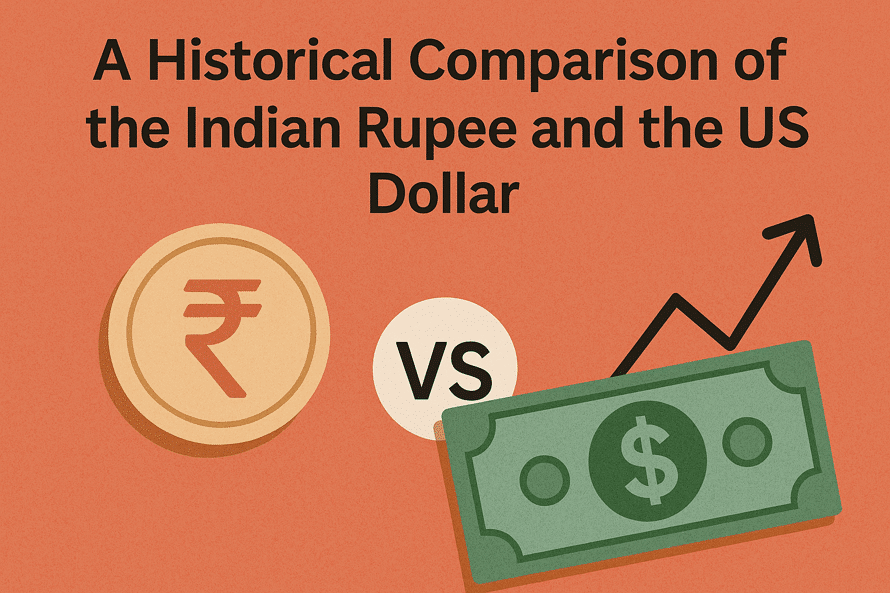
Introduction: INR vs USD – A Story of Two Currencies
The Indian Rupee (₹) and the US Dollar ($) are more than just currencies—they’re mirrors of their nation’s economic stories. One is among the oldest, tracing back to ancient India; the other is modern, born in the age of revolution. Today, understanding the evolution of INR vs USD is crucial for Indian investors, global traders, and anyone curious about economic power dynamics.
Ancient Origins: A Coined Legacy
The Indian Rupee
The rupee’s history dates back to the 6th century BCE, with roots in Sanskrit terms rūpa (form) and rūpya (wrought silver). Sher Shah Suri gave India a standardized silver coin in the 16th century—Rūpiya—which shaped Indian coinage for centuries.
The US Dollar
Though officially adopted in 1792, the US dollar has its foundation in the Spanish silver dollar, also called the piece of eight. The dollar’s name even comes from the “thaler,” a European coin. By 1785, the Continental Congress chose the dollar, and the Coinage Act of 1792 set it in motion with a decimal system.
Colonial Transformations and Independence
Rupee Under British Rule
The East India Company minted rupees from 1671. The 1835 Coinage Act standardized the rupee across India. After independence, India issued its first national coins in 1950 and embraced decimalization in 1957.
The Dollar’s Nationalization
Before the US Mint (1792), Americans used various foreign coins. The dollar was initially backed by silver and gold, evolving to the Gold Standard in 1900 and finally shedding gold ties under the Nixon Shock in 1971, becoming a fiat currency.
Central Bank Powers: RBI vs Fed
- Reserve Bank of India (RBI): Established in 1935, nationalized in 1949. Manages currency issuance, inflation control, and exchange rate interventions.
- Federal Reserve (Fed): Founded in 1913. Controls money supply via interest rates, QE, and open market operations. Influences global liquidity due to USD’s reserve status.
The Rupee-Dollar Exchange Rate Through the Years
Here’s a snapshot of how the INR has moved against the USD since 1947:
| Year | ₹ per $ |
|---|---|
| 1947 | 3.30 |
| 1966 | 7.50 |
| 1991 | 22.74 |
| 2000 | 44.94 |
| 2013 | 56.57 |
| 2020 | 76.38 |
| 2025 | 85.32 |
This long-term decline reflects India’s inflation, oil dependence, and trade deficits. But behind each dip lies a story.
What Led to the Rupee’s Depreciation?
1. 1966 Devaluation
Wars with China (1962), Pakistan (1965), and droughts pushed India to devalue the rupee to ₹7.50 per USD.
2. 1991 Economic Crisis
With foreign reserves barely covering two weeks of imports, India liberalized its economy and let the rupee fall to ₹25.92.
3. 2008 Global Financial Crisis
The crisis triggered capital flight from emerging markets like India, weakening the rupee further.
4. Oil Shocks & Imports
India imports over 80% of its crude oil. When oil prices rise, the rupee takes a hit.
5. 2016 Demonetization
Though aimed at reducing black money, the shock move disrupted cash-driven sectors and slowed economic momentum.
Why the US Dollar Remains Strong
- Bretton Woods Legacy: Pegged global currencies to the USD post-WWII.
- Safe Haven Appeal: Investors flock to the dollar during global uncertainty.
- Fed’s Influence: US interest rate hikes often strengthen the dollar.
- Global Trade Dominance: Most international transactions happen in USD.
INR vs USD: What Drives the Tug of War?
| Factor | INR | USD |
|---|---|---|
| Inflation | Higher | Lower |
| Interest Rates | Volatile | Globally influential |
| Trade Balance | Deficit | Mixed |
| Currency Management | RBI intervention | Market-driven |
| Global Confidence | Growing | Established |
Will the Rupee Ever Strengthen Against the Dollar?
It’s possible—but unlikely without structural reforms. To reverse the long-term trend:
- India must improve productivity and exports.
- Reduce dependence on oil imports.
- Maintain stable inflation.
- Attract long-term foreign investment.
As long as the USD remains the global default currency and India runs trade deficits, the rupee will likely continue its slow depreciation.
Conclusion
The INR vs USD story isn’t just about exchange rates—it’s about economics, politics, crises, and growth. While the rupee has weakened over the decades, India’s economic base has broadened. And though the dollar reigns supreme today, currency supremacy is never permanent. The past teaches us that policy, resilience, and strategy matter.
So, whether you’re investing, trading forex, or just curious—tracking the rupee-dollar saga is tracking history in motion.
FAQs
When was the Indian Rupee introduced?
The term ‘rupee’ dates back to the 6th century BCE, with modern coins introduced by Sher Shah Suri in the 16th century.
What caused the 1991 Indian currency crisis?
A balance of payments crisis due to high imports and low reserves led to a steep rupee devaluation and economic liberalization.
How is the INR/USD exchange rate determined?
It’s a mix of market demand/supply and RBI interventions through the managed float system.
Why does the dollar strengthen during crises?
Because it’s considered a safe-haven asset—investors trust it during uncertain times.
What is the role of RBI and the Fed?
Both manage monetary policy, but the RBI intervenes more actively in forex markets to stabilize the rupee.
Why has the Indian Rupee been falling against the US Dollar?
Due to higher inflation in India, trade deficits, crude oil dependency, and global economic uncertainty. Foreign investors also tend to pull out during crises, weakening the rupee.
Is the US Dollar losing its dominance?
While there’s chatter around “de-dollarization,” the USD still commands over 85% of global forex reserves and remains the most trusted safe-haven asset.
Can India make the rupee stronger?
Yes, but it requires reforms in manufacturing, export competitiveness, reduced fiscal deficits, and energy independence.
What was the strongest point for the Indian Rupee against the US Dollar?
Right after independence, in 1947, the exchange rate was ₹3.30 per USD. Since then, it has largely depreciated.







